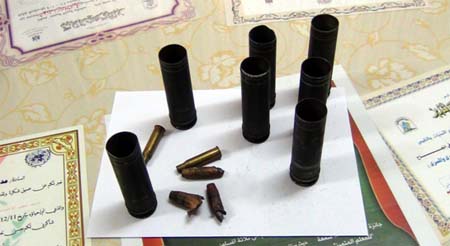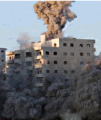Home > Rubriques > Languages - International > English > Occupied lives: Education under attack
PCHR
Occupied lives: Education under attack
Mercredi, 26 septembre 2012 - 17h44
Wednesday 26 September 2012
============================================
class="twitter-follow-button" data-show-count="false"
data-lang="fr">Follow @PalestinePlus
Shuhada Khuza’a is a secondary school that lies 500 meters from the border between Khan Yunis, in the southern part of the Gaza Strip, and Israel. This school was established in 2002 and serves the entire population of the small farming village of Khuza’a.
Due to its proximity to the ‘buffer zone’, the school is subject to frequent shootings from tanks and shelling from drones. The ‘buffer zone’ is a military no-go area which was unilaterally imposed by Israel in 2007. It extends along the entire northern and eastern perimeter of the Gaza Strip adjacent to Israel, but inside Palestinian territory. In 2009, Israel announced that the ‘buffer zone’ would extend 300 meters into Gaza, but the precise area designated by Israel as a ’buffer zone’ is unknown and, in reality, it can extend as far as 1,500 meters. The establishment of the ‘buffer zone’ is illegal under international law. The buffer zone is often enforced using live fire, which results in the loss of Palestinian lives, land and property. An example of this enforcement is the 5 automatic Israeli sniper towers near Shuhada Khuza’a which shoot at anyone who ventures into the 300 meters.
Akram Assad has been the director of Shuhada Khuza’a for 2 years and can easily describe the kind of conditions that his 300 students face on a daily basis: “There have been so many attacks on this school, sometimes even twice in one month. No prior warning is usually given, even though some of the attacks happen when school is in session. On 14 June 2012, for instance, the school was shelled just a bit after the children left. Most often, the attacks come from tanks shooting shells, but sometimes we have drone attacks after school hours. When the shooting begins, we make the students lie on the ground in their classrooms or gather them in one place and wait for the shooting to stop. We have no way to leave or escape once an attack begins. Once, the tanks came up to the school and we all stayed behind for 2 hours after school, because even the ICRC could not coordinate for us to leave.”
The constant attacks have had a negative effect on the teachers and students of Shuhada Khuza’a: “The children are always nervous and feel scared. These psychological problems are reflected in their poor grades and discipline issues. In the morning, if they see tanks around the buffer zone, they simply do not show up for school that day. The teachers are also scared, so how can they be expected to help the children? It is obviously very hard to learn or teach under these conditions.”

Ammunition collected in Shuhada Khuza’a after one of the attack
Some of the structures in the school remain unrepaired from previous attacks. This can be attributed to the closure of the Gaza Strip and the subsequent ban on imports, which has resulted in the limited availability and prohibitively high prices of building materials. The computer classroom, for instance, has a gaping hole in one of its walls resulting from a previous attack. Further to this, bullet holes in some of the windows and corridors serve as evidence of repeated attacks on the school. One of the buildings is considerably damaged, and has metal rods protruding from a section of the wall: “A fletchete bomb was dropped on the school one night and the shrapnel chipped some of the walls. We have yet to receive help to reconstruct the damaged structures. Sometimes, when the buildings get damaged, we form committees, approach businessmen or ask the children’s parents to contribute towards repairs.”
For some of the students, the attacks and their effects are not only limited to their school life: “During ‘Operation Cast Lead’ in 2009, 4 of our students died and 9 students were orphaned. A sizeable number of our current students have had their homes destroyed completely or partially by Israel’s forces. When they go home, they cannot even study or do their homework. They have serious psychological problems and we try to keep them close to their teachers, so that they can receive counseling and assistance with their studies. We also try to engage them in sports such as football, as a way of helping them to forget about their problems.”
Irrespective of the significant challenges, Akram hopes that the situation and learning conditions will improve in Shuhada Khuza’a school: “I do not know if these attacks are meant to incite fear in the children or make us leave the area. This school is the only secondary school in Khuza’a and next year we will have even more students. It is dangerous here and there is no safe place to hide from the attacks. We just wish and hope for the same things as schools in other countries. In particular, we need a room for the psychology teacher, because it is one of our priorities to address the psychological problems that these children have. We also hope that this area will be peaceful one day.”
Under Article 53 of the Fourth Geneva Convention, the destruction of private property is prohibited unless rendered absolutely necessary by military operations. Further, according to the second paragraph of Article 8 (b)(i) and (ii) of the Rome Statute of the International Criminal Court, both “intentionally directing attacks against the civilian population as such or against individual civilians not taking direct part in hostilities” and “intentionally directing attacks against civilian objects, that is, objects which are not military objectives” constitute war crimes.
Public Document


